
You’ve probably heard the saying, “What you don’t know can’t hurt you.” Unfortunately, when it comes to your health, what you don’t know can hurt you! Sleep apnea is a great example. This common condition affects millions of people, many of whom don’t know they have it, and increases the risk for many serious health problems. Not to mention that it impacts your energy levels, mood, and overall quality of life. Keep reading to find out what sleep apnea in Lacey is, the symptoms to watch for, and how easy effective treatment can be!
What Is Obstructive Sleep Apnea?
The word “apnea” is a Greek word meaning without breath, so it’s no surprise that sleep apnea refers to frequent, involuntary pauses in breathing that happen during sleep. These interruptions can last more than 10 seconds and occur up to 30 times an hour.
The most common type of sleep apnea is obstructive sleep apnea (OSA) in which the airway becomes blocked or obstructed. This can be caused by the soft tissues (tongue, adenoids, or tonsils) become so relaxed at night that they block the airway.
Sleep Apnea Symptoms and the Importance of Being Screened
It’s thought that 80% of people with sleep apnea don’t know they have it. Some doctors have estimated that untreated sleep apnea triples a person’s risk of early death, so being undiagnosed (and untreated) is quite serious.
Here are some common sleep apnea symptoms in Lacey to watch for:
- Being told that you snore loudly or periodically gasp for breath during sleep
- Daytime sleepiness or lack of energy
- Weight gain
- Regularly waking up with a dry mouth or sore throat
- Headaches, especially in the morning
- Difficulty paying attention at work or school
- Mood disorders such as depression and irritability
Common risk factors for sleep apnea are age, excess body weight, nasal congestion, and alcohol or sedative use. However, even people with a healthy body weight who have none of the usual risk factors can develop sleep apnea, so it’s crucial to be screened. Especially since there’s simple, effective treatment available.
Treatment Is Easier Than You Thought
The first step is diagnosis, which can be done by scheduling a visit with a dentist who can refer you for a sleep study. If you do have sleep apnea, treatment is easier than ever. For many years, the only options were a CPAP machine or surgery. Now, a dentist can custom-make an oral appliance that works by repositioning your lower jaw and tongue to open your airway at night. These appliances are lightweight, portable, and very effective for mild to moderate sleep apnea.
Getting enough high-quality sleep each night lowers the risk of many diseases and improves your quality of life. With proper diagnosis and treatment, you can get the sleep you need to live your best life!